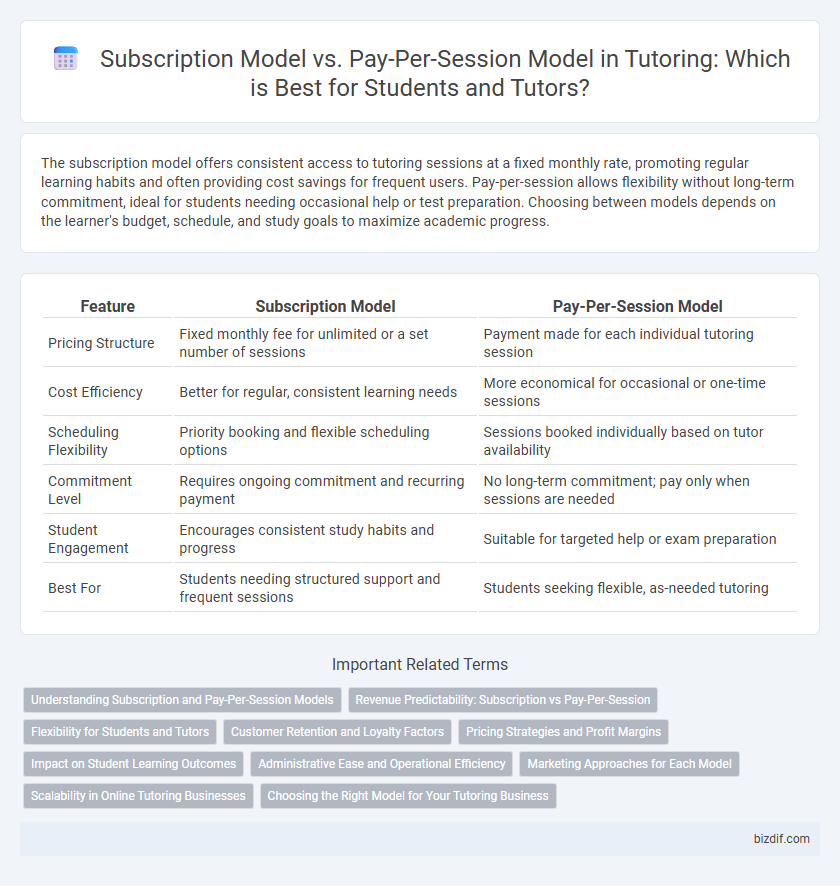The subscription model offers consistent access to tutoring sessions at a fixed monthly rate, promoting regular learning habits and often providing cost savings for frequent users. Pay-per-session allows flexibility without long-term commitment, ideal for students needing occasional help or test preparation. Choosing between models depends on the learner's budget, schedule, and study goals to maximize academic progress.
Table of Comparison
| Feature | Subscription Model | Pay-Per-Session Model |
|---|---|---|
| Pricing Structure | Fixed monthly fee for unlimited or a set number of sessions | Payment made for each individual tutoring session |
| Cost Efficiency | Better for regular, consistent learning needs | More economical for occasional or one-time sessions |
| Scheduling Flexibility | Priority booking and flexible scheduling options | Sessions booked individually based on tutor availability |
| Commitment Level | Requires ongoing commitment and recurring payment | No long-term commitment; pay only when sessions are needed |
| Student Engagement | Encourages consistent study habits and progress | Suitable for targeted help or exam preparation |
| Best For | Students needing structured support and frequent sessions | Students seeking flexible, as-needed tutoring |
Understanding Subscription and Pay-Per-Session Models
The subscription model offers students unlimited access to tutoring sessions for a fixed monthly fee, promoting consistent learning and budget predictability. In contrast, the pay-per-session model charges students individually for each tutoring session, providing flexibility without long-term commitment. Understanding these models helps students choose the best option based on their learning frequency, financial preferences, and educational goals.
Revenue Predictability: Subscription vs Pay-Per-Session
Subscription models offer consistent monthly revenue, enhancing cash flow stability and enabling better financial planning for tutoring businesses. Pay-per-session models generate variable income based on session frequency, leading to fluctuating revenue and challenges in forecasting. Reliable cash inflow from subscriptions supports scaling operations and investing in quality improvements.
Flexibility for Students and Tutors
Subscription models provide consistent scheduling and predictable income for tutors, offering students the advantage of regular, structured learning sessions. Pay-per-session models grant greater flexibility by allowing students to book lessons as needed without long-term commitments, accommodating fluctuating availability for both parties. This flexible approach benefits tutors by enabling them to adjust their workload based on demand, while students can tailor tutoring to their immediate academic needs.
Customer Retention and Loyalty Factors
Subscription models in tutoring foster higher customer retention and loyalty by providing consistent access to educational resources, encouraging long-term commitment. Pay-per-session models offer flexibility but may lead to sporadic engagement and less predictable loyalty patterns. Emphasizing personalized learning plans and seamless user experiences within subscription services enhances sustained client satisfaction and repeat enrollment.
Pricing Strategies and Profit Margins
Subscription models in tutoring offer predictable revenue streams with consistent cash flow, leveraging bulk pricing to attract long-term clients and often increasing customer retention through discounts or added value. Pay-per-session pricing appeals to flexibility, allowing tutors to charge premium rates per session, which can maximize profit margins for occasional or specialized lessons but may result in less stable income. Strategic optimization of each model depends on balancing client acquisition costs, frequency of sessions, and retention rates to enhance overall profitability in the tutoring business.
Impact on Student Learning Outcomes
The subscription model fosters consistent learning by encouraging regular practice, which enhances long-term knowledge retention and skill mastery in students. In contrast, the pay-per-session model often leads to sporadic engagement, potentially limiting steady progress and deeper comprehension. Data shows that students subscribing to ongoing tutoring services demonstrate higher academic improvement and sustained motivation compared to those using one-time sessions.
Administrative Ease and Operational Efficiency
Subscription models streamline administrative tasks by automating billing and scheduling, reducing manual intervention and minimizing payment delays. Pay-per-session models require frequent transaction processing and individualized scheduling, increasing administrative workload and potential for errors. Overall, subscription plans enhance operational efficiency through predictable revenue flows and simplified management, while pay-per-session demands more resources to maintain smooth operations.
Marketing Approaches for Each Model
Subscription models rely on creating long-term customer relationships through value-driven content marketing and personalized email campaigns to boost retention rates and brand loyalty. Pay-per-session models emphasize targeted advertising, seasonal promotions, and limited-time offers to attract immediate sign-ups and capitalize on impulse decisions. Leveraging data analytics helps tailor marketing strategies by identifying customer preferences and optimizing budget allocation for both tutoring models.
Scalability in Online Tutoring Businesses
Subscription models enhance scalability in online tutoring businesses by providing predictable, recurring revenue streams and increasing customer retention rates. Pay-per-session models often lead to fluctuating income and pose challenges in forecasting growth, limiting the ability to invest in marketing and platform improvements. The subscription approach enables efficient resource allocation, supporting expansion and the onboarding of more students without compromising service quality.
Choosing the Right Model for Your Tutoring Business
Choosing the right pricing model for your tutoring business depends on factors like client retention, cash flow stability, and flexibility. Subscription models provide predictable monthly revenue and encourage long-term commitment, while pay-per-session offers flexibility and appeals to clients seeking occasional help. Analyzing your target market's preferences and tutoring frequency helps optimize profitability and customer satisfaction.
Subscription Model vs Pay-Per-Session Model Infographic

 bizdif.com
bizdif.com